#rayon cotton fabric
Text
Explore the enchanting world of rayon fabrics and discover its fascinating history, versatile applications, and myriad benefits. Read our informative blog today!
#rayon fabrics#viscose#rayoncrepe#rayon fabric for kurti#unstitched rayon fabric#rayon cotton fabric#rayon fabric clothes#rayon fabric examples#rayon fabric synthetic#rayon fabric vs cotton#viscose rayon fabric#rayon material#rayon cloth#rayon slub fabric#polyester rayon fabric#rayon fabric good for summer#viscose clothing#rayon dress material online#rayon in summer
0 notes
Text

pineapple by stacey beach, cotton, rayon, screen printed cotton, wool, thread, batting & canvas, 68 x 46 inches
130 notes
·
View notes
Text

IT'S FINALLY (almost) DOOOOONE
#just gotta clean up the spaghetti in the back (tuck in all the tails)#i used something like 2-1/2 skeins of embroidery thread cause a tight whip stitch like that eats thread so fast#one arm's length of thread (split into three lengths of two strands each) would only get me a couple inches of stitch#and since the fabric store was out of black cotton thread i had to use rayon which suuuuucked to work with#it doesn't like to stay a thread so the back is basically a cloud#but also it doesn't like to break so it's a very stubborn and hard to remove cloud#ANYways ive been working on this for like three weeks straight i'm so relieved it's show-ready before the show this weekend#i think if/when i do another for my other costumes i might try and do the straighter lines by machine and the details by hand#because good god this took forever#i'd have to do some tests tho#because of the thickness of the cardboard pattern the end result turned out way fatter than intended (i'm still happy tho)#i might try and shave the pattern down a lil or just cut a new smaller one#idk how the machine embroidery would look next to the hand-done stuff either...
8 notes
·
View notes
Text
Finished my mom's dog's sweater and honestly might make another knit tie because they're so little and fun to experiment with.
#using tumblr like a diary#this is in reference to my lupin iii cosplay knit tie experimenting i've been doing#earlier i got some mercerized cotton lace yarn/crochet thread (??) from daiso with this thought in mind#linen stitch in rayon looks surprisingly nice but i'm curious if i can more closely imitate the fancy “cri de la soie” kind#i've seen it and it's a very open fabric. i'm going to try moss stitch on too-large needles#which is nearly the opposite of linen stitch on too-small ones
3 notes
·
View notes
Text
Traveling enriches one’s self through the experience of visiting new places, cultures, and cuisines. However, for most of us, while on a packing spree, the most challenging task is to go light with the suitcase and yet in style with the ethnic wear. Ethnic attire is full of vibrant colours and elaborate designs and is highly cross-cultural, holding infinite possibilities of being versatile and travel-friendly if chosen well. Here is how you can pack light and look fabulous in your ethnic wear when traveling.
#adventure-ready ethnic outfits#capsule wardrobe#comfortable ethnic wear#cotton kurtas#cultural heritage#eco-friendly travel clothes for women#clothes for women#eco-friendly travel essentials#ethnic fabrics#ethnic wardrobe tips for vacation#wardrobe tips for vacation#explore travel friendly clothing#indian ethnic outfits#kurta sets#latest ethnic wear for women#linen kurtas#maxi dresses#multipurpose items#online shopping for women#packing cubes#packing light#rayon ethnic wear#silk blends#stylish travel wardrobe#travel collection#travel friendly ethnic wear for ladies#travel friendly ethnic wear outfits#travel outfits for women#travel steamer#travel wear for women
0 notes
Text
“Bamboo is antifungal”
Because it’s rayon
“Eucalyptus fabric is cooling!”
Yeah, because it’s rayon
“We make clothing called seacell out of seaweed!”
Yeah I looked on your website it’s made by the lyocell process, which means-
-wait for it-
It’s fucking rayon!!
Listen. There is a list of actual plant fibers that are directly made into fabric: cotton, linen, ramie, some hemp. I’m sure I’m missing a couple.
But if you’re wondering “huh how did they turn that plant material into fabric,” 99% of the time? It’s RAYON.
All rayon is made by putting plant material in chemical soup, dissolving out everything but the cellulose, and turning the cellulose into filaments/fibers.
The source of the cellulose has zero effect on the eventual fabric.
Rayon made from bamboo or eucalyptus or seaweed is not any better than rayon from any other sources.
Don’t let companies mislead you!
#rayon#I’ve ranted about this before#I will die on this hill#it makes me so mad that the labeling laws have gotten lax on this#my posts#anyway got into an argument w someone on fb about it lol
15K notes
·
View notes
Text
#handloommagic#srishakthitex#sri shakthi tex#Cotton fabrics#Rayon fabrics#Plain grey fabrics#White shirting fabrics#Ayurvedic fabrics#Shirts#Tops#Blouses#Kurtis#Ethnic wear#Dresses#Aprons#Gloves#Cleaning fabrics#Curtains#Coats#Suits#Jackets
0 notes
Text
Timeless Elegance: Cotton Fabric Material Collection at Murphy's Lane
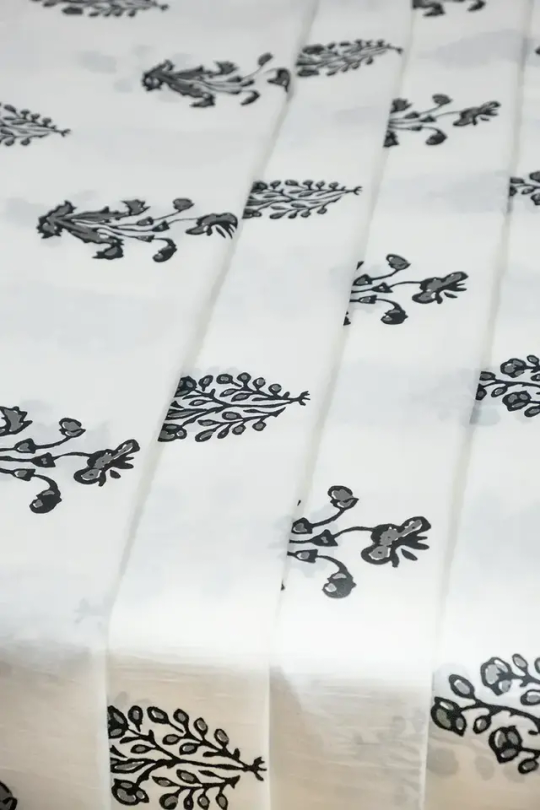
ndulge in the classic charm and versatility of our Cotton Fabric Material Collection at Murphy's Lane. Explore a curated selection of high-quality cotton fabrics in a spectrum of colors and patterns. Elevate your creative pursuits with the luxurious feel of cotton. Shop online for the finest cotton fabrics, exclusively at Murphy's Lane.
0 notes
Text
Explore Top-Quality Cotton Fabric Material at Murphy's Lane | Elevate Your Creations with Unmatched Comfort and Style
Dive into the world of Cotton Fabric Material at Murphy's Lane. Uncover a diverse range of premium cotton textiles, carefully curated to bring unparalleled comfort and style to your creative projects. Shop online for the finest quality fabrics.
1 note
·
View note
Text
National Garment Fair 2023 in Mumbai by CMAI from July 18–21
This must-attend event provides a special platform for connecting clothing producers with retailers, distributors, and agents. It is the ideal location to learn about the newest trends in the clothing business and cultivate connections with key players.
The National Garment Fair 2023, which is taking place in the vibrant city of Mumbai, is the ideal venue for garment makers to display their goods to a large audience.

#news#National Garment Fair#clothes#readymade garments#fabric#cotton#linen#craft#patterns#garmentmanufacturer#garmentfactory#apparel#clothing#fashion#rayon#design#woven#labelclothing#retail#fashionstyle#dress#tshirt#brand#fashiondesigner#sewing#fashiondesign#clothingbrand#made in india#india#mumbai
0 notes
Text
Elevate your style with Rayon Fabrics!
Check out different tips to style Rayon Fabrics in your daily life.
#fabrics#fabric suppliers brisbane#rayon fabrics#floral fabric#cheap fabrics#cotton clothes#fabrics sale
0 notes
Text
Don't miss our comprehensive guide, "Rayon vs. Polyester: Understanding the Differences and Choosing Wisely." Upgrade your textile knowledge and make a wise choice for you and the environment!
#rayon fabrics#rayon material#rayoncrepe#viscose rayon#rayon cloth#polyester#polyester fabric#cotton polyester fabric#polyester rayon fabric#polyester cotton#buy fabric online#fabric store online#online fabric#fabric store#fabric online shopping#buy clothes online
0 notes
Text
20 DIFFERENT TYPES OF FABRIC AND THEIR USES
Whether you are making new clothes or trying to figure out how to clean clothes, understanding the right fabric piece is always essential. This is beneficial when you have a nice piece of fabric and you want it to stay for a long period of time. The trends and preferences of people regarding clothing and fashion are continuously changing, and hence the fabric industry is coming up with various new kinds of designs and stitching. There are different kinds of fabrics available that you can choose as per your comfort and choice. If you are asked how many fabrics are available on the market, then you will hardly count 12 or 14 types of fabrics. Isn’t it? But, if I say that there are more than 200 types of fabrics available worldwide. What would be your reaction? Different types of fabrics are used for different purposes; some of them are old while some are newly invented. Also, you need to treat that fabric in the right way because each and every fabric contains different properties that strongly influence how you treat your clothing. DTMPL is one of the most known Textile Manufacture In India, so if you are willing to buy such fabrics, then you can get in touch with us.

TYPES OF FABRIC AND THEIR USES
Ticking Fabric: This is a kind of woven fabric that is made up of linen fibers and cotton. This is mainly used for pillows and mattresses.
Tissue fabric: This is also a kind of woven fabric that is made up of man-made fibers and silk. This is basically used for sarees and women’s dress material.
Velvet fabric: This woven fabric comprises cotton, wool, silk, linen, etc. This fabric is used to make daily wear clothing, home décor etc.
Terry cloth: this woven fabric is made of cotton and blended with synthetic fiber. It has a loop pile on both sides and sometimes at one side. This is mainly used in producing towels.
Voile fabric: This fabric is made up of different kinds of fibers, mainly from cotton. This is one of the most commonly used fabrics in India as it is mainly used for blouses and dresses.
Warp knitted fabric: knitted fabric is made up by a special knitting machine with yarns from warp beams. This is also the most used fabric in India. This is mainly used for mosquito netting, inner wear such as; panties, lingerie’s, girdles, hooks, eye tape, camisoles, brassieres etc.
Whipcord fabric: Knitted fabric is made up of hard twisted yarn with diagonal rib and cord. This is mainly used to design comfortable and durable outdoor clothing.
Tricot knit fabric: This fabric is made up of exclusively filament yarn, mainly used for fitting comfort stretch items like sportswear, and swimwear.
Velour knitted fabric: Velour knitted fabric is made up of an additional set of yarn that makes pile loops on the fabric surface. This is mainly used for making jackets and dresses.
Terry knitted fabric: This woven fabric is made up of two sets of yarn, where one makes the pile and the other makes the base fabric. This is mainly used in making beachwear, bathrobes, towels and many more.
Tartan fabric: Previously, this fabric could only be made of wool, but tartan fabric can now be made of any material.It is suitable for making daily wear clothes and other fashion designs.
Sateen fabric: Sateen fabric is made up of spun yarns and is mainly used for making decorative items and other clothing purposes.
Shantung fabric: This fabric is made up of fiber and silk and also similar kinds of silk fabrics. This fabric is mainly used for making bridal gowns and other kinds of designer dresses.
Sheeting fabric: This is a kind of fabric that can be made of 100% cotton or a blend of polyester and cotton. This is mainly used for bed covering.
Silver knit fabric: It is a kind of knitted fabric that is made up of a special circular knitting machine. This is widely used for coats and for making jackets.
Taffeta fabric: This fabric is manufactured from different kinds of fibers such as silk, nylon, and rayon. Taffeta is mainly used for making women’s designer clothes and garments.
Stretch fabric: This is a special kind of fabric that can be stretched in all four directions. This is mainly used in making sports and gym wear.
Rib stitch knit fabric: This fabric is mainly used for wool, cotton blends, acrylic, or cotton. This is mainly used for designing the lower edge of sweaters, sleeve cuffs, necklines etc.
Plain fabric: This fabric is made up of weft and warp yarns in a pattern of under one and over one. This is popularly used for making leisure wear.
Jersey knitted fabric: This fabric is generally made up of wool but is currently also made up of synthetic and cotton fiber. This fabric is widely used for making bed sheets, sweatshirts, and a variety of household and clothing items.
DTMPL is one of the most known fabric manufacturers in India and also specializes in cotton fabric manufacture, polyester lycra fabric manufacturer, rayon fabric manufacturer, acrylic fabric manufacturer, and many more. Get in touch with us today to know more about our products and services as well as the most commonly used fabrics in India.
This blog is originally posted here: https://dtmpl.com/20-different-types-of-fabric-and-their-uses/
#fabric#fabric manufacturers#cotton fabric manufacture#polyester lycra fabric manufacturer#rayon fabric manufacturer#acrylic fabric manufacturer#DTMPL#top textile industry in india
1 note
·
View note
Text
Sewing 1890s Day Dress in Doll Scale
I went slightly overboard with this second historical doll project. Here's my first one. The style is from around 1897 and more of a middle class style. As with my first doll outfit, I tried to stick to historical methods as much as possible, but the scale forced me to do some deviations. I hand-sew everything though sewing machine was already widely used, because in this scale it's easier to control the stitch, there's not that much to sew anyway and also I just really like hand-sewing. Here's all the items I made. As said, I went a little overboard. One thing that's missing is the corset cover, but the layers of fabric were creating enough bulk on the waist as is so I decided to not make one.

This time I decided to try repainting the face. I don't have any doll customization materials, so I used acrylics. After couple of attempts I got decent results. Acrylics can't make as smooth and delicate finish as pastels, pencils and gouache, which can be used on vinyl with basing sprays, and I'm not experienced with painting small details on 3D objects, so it's a bit smudged at points, especially with the other eye. I aimed for 1890s very neutral make up and the type of expression that was popular in fashion plates and other illustrations.
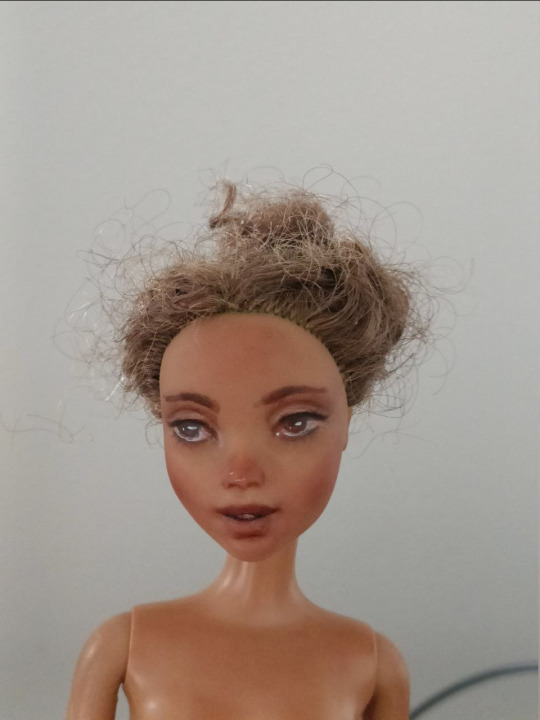
Undergarments
Combinations and stockings
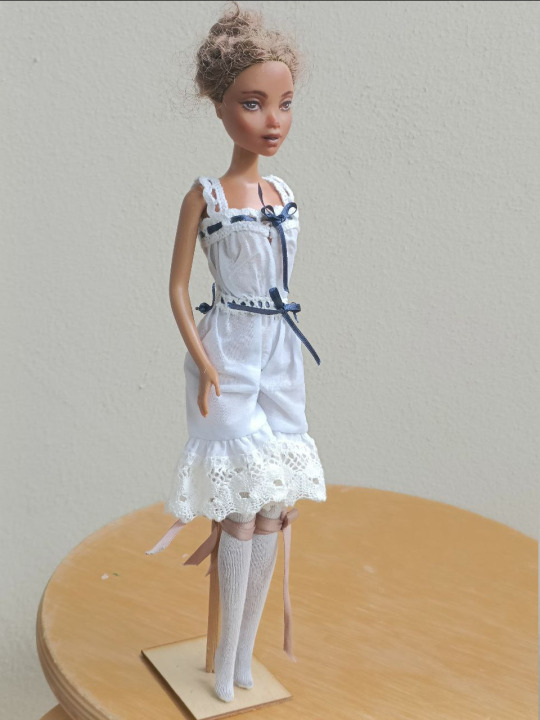
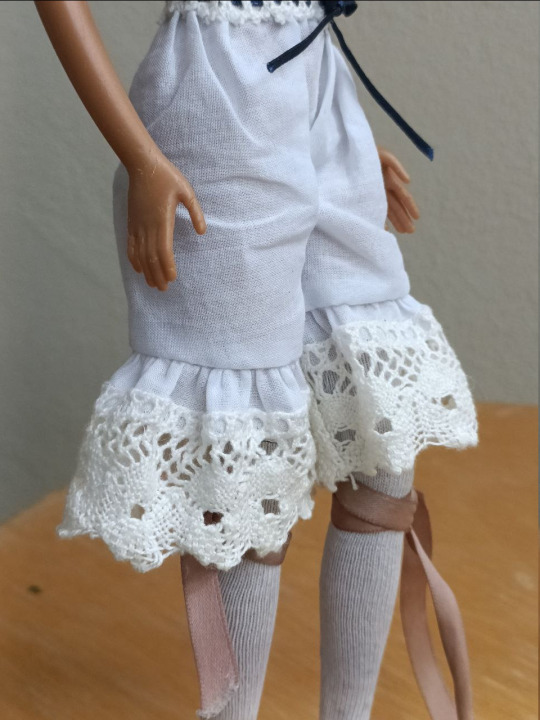
The combinations are split crotch as they were in the period. They are from thin cotton voile I have a lot of and is very appropriate. I didn't have really tiny enough lace for this, so it's kinda bulky, but I think it's okay enough. The stockings are cotton knit, which fits well. The garters are not actually necessary for this doll since her legs are rubbery.
Corset
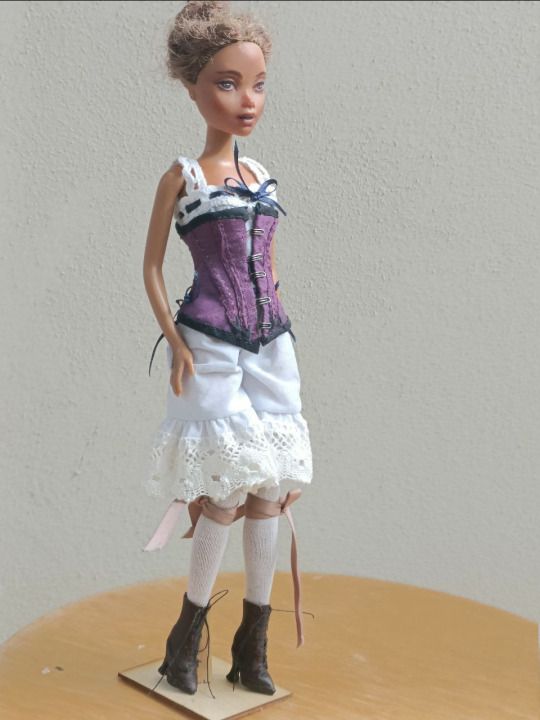

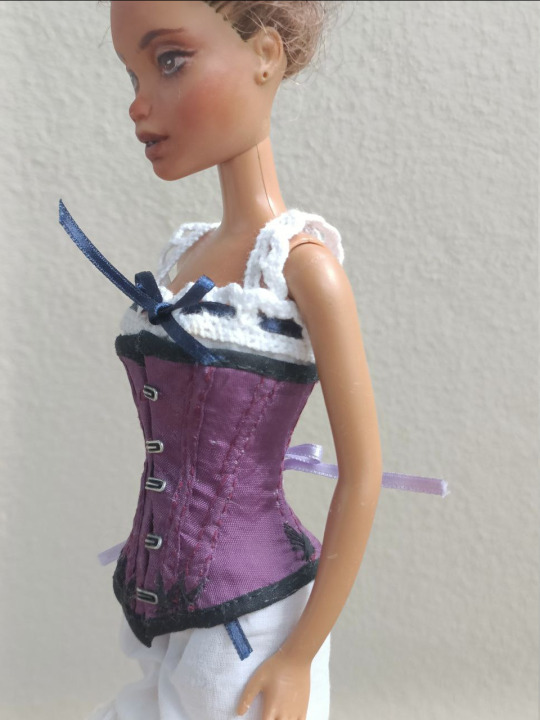
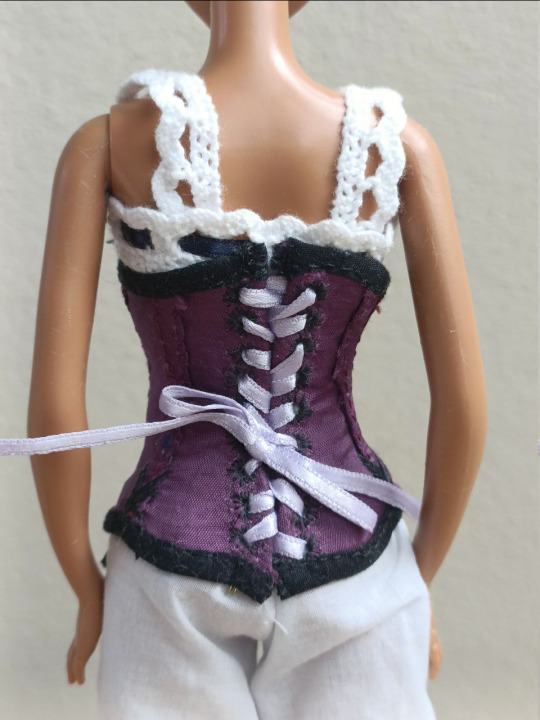
I made the corset from a firm-ish linen and satin rayon pretending to be silk as the fashion fabric. The stitching of the boning channels is not super neat, this fabric is very unforgiving, I didn't have exactly matching thread and the scale made it very difficult. I of course didn't have tiny busk, so I used small hooks, sewed thread loops for them and used narrow metal wire for the edges. I think it looks surprisingly right on the outside. I used the same wire as the boning to reinforce the lacing on the back. I didn't actually use boning elsewhere but the tightly packed linen edges in the boning channels kinda work like lighter boning. I think it keeps the shape pretty ways even with just that. I stitched cotton tape inside to shape the corset further. I also didn't have tiny metal eyelets so I hand-sewed the lacing holes.
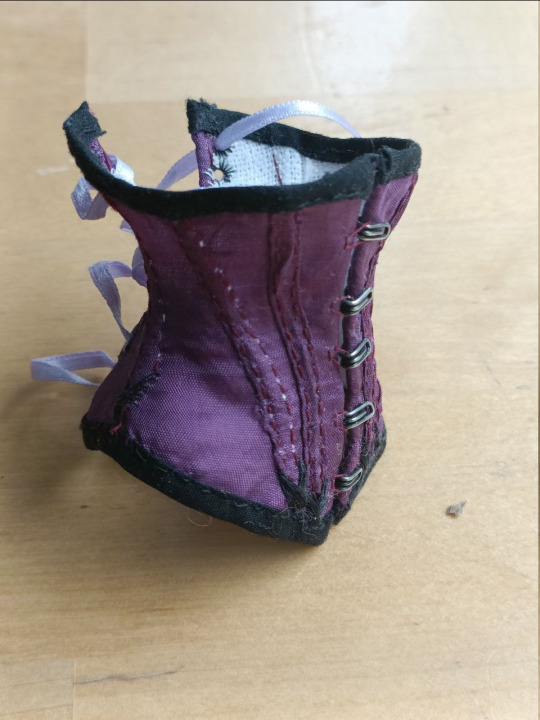
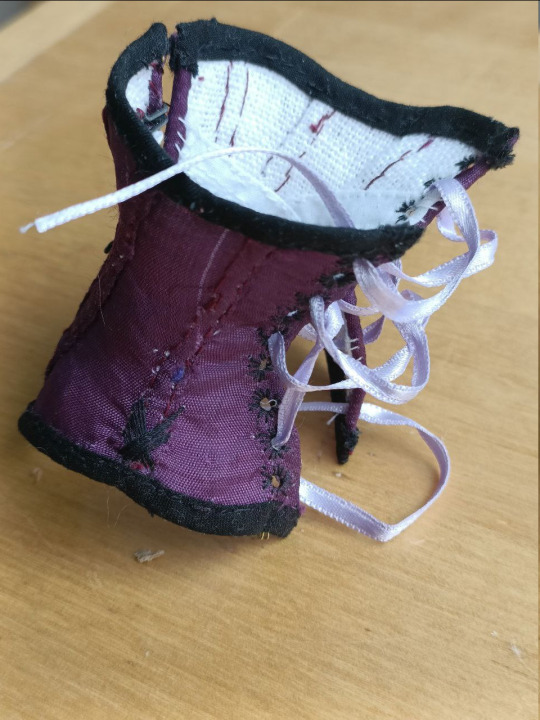
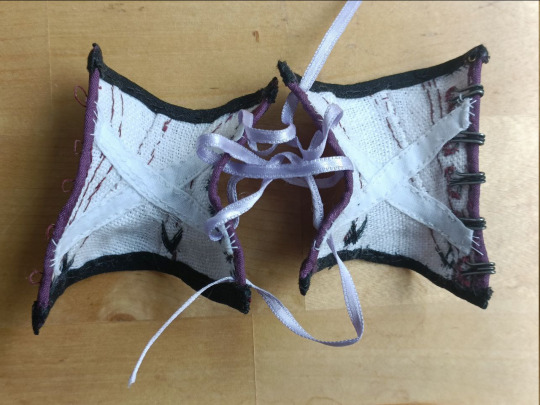
Bustle pad
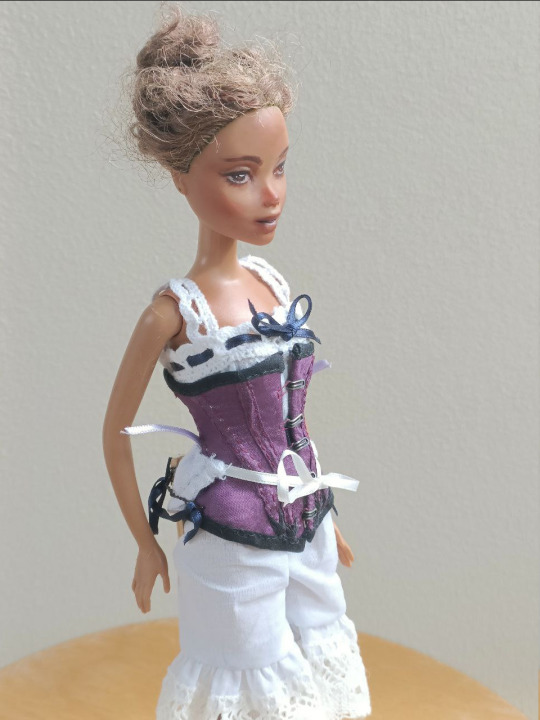

The bustle pad is from linen and stuffed with tiny cabbage.
Petticoat
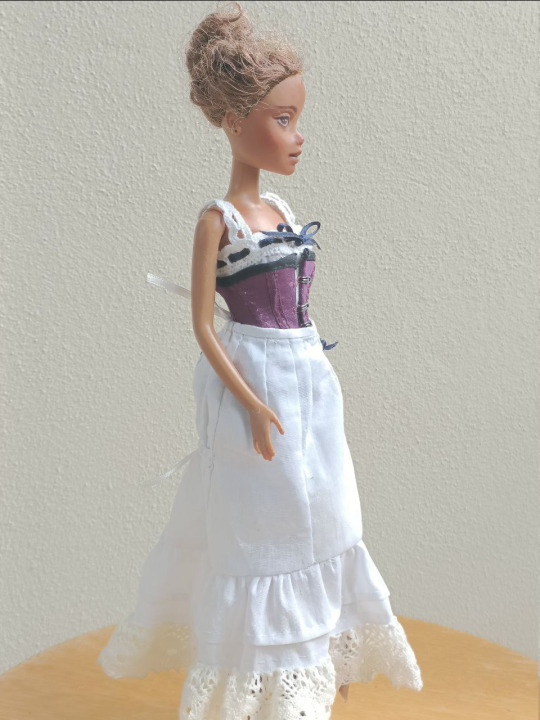

The petticoat is from the same cotton as the combinations.
Outer wear
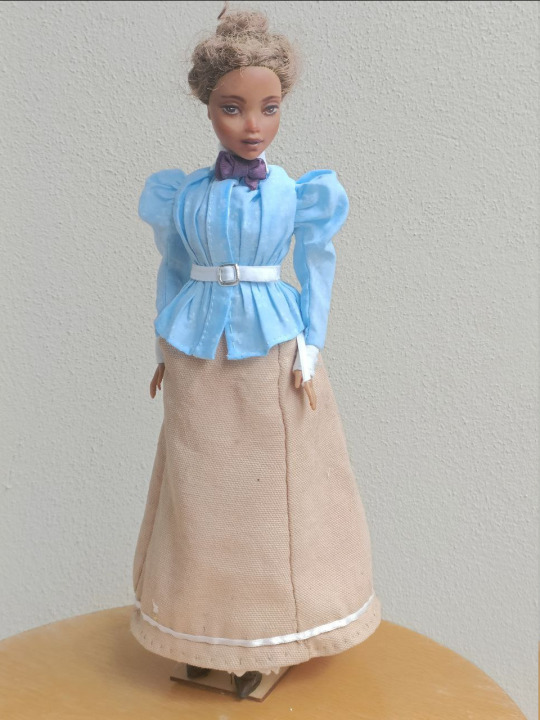

Skirt
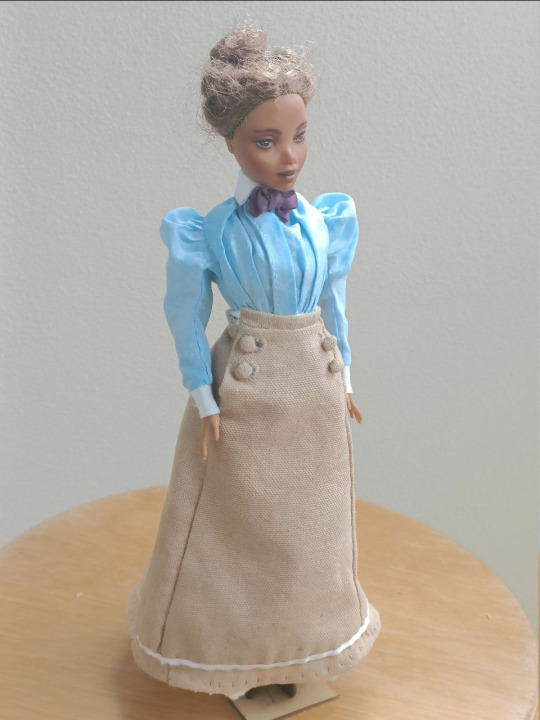
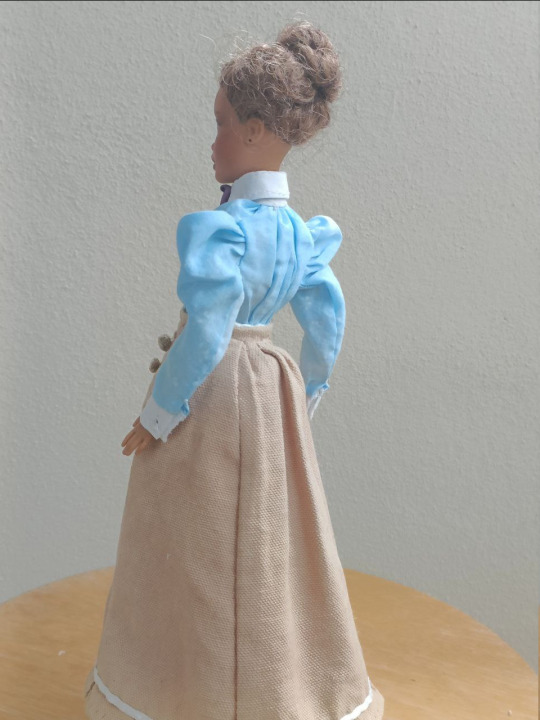
The fabric is cotton half-panama. It's pretty thin, but firm. I would have liked to use a woven wool, but I didn't have any that's thin enough to work in this scale. I think this cotton looks close enough in this scale to a wool with a tight weave, so I'm imagining it's that. My problem was that the cotton was white, but I wanted light brown. I wasn't going to buy any fabric for this, so I did the reasonable thing and dyed it with red onion peals (I've been doing natural dye experiments so this worked well for me).
Shirtwaist
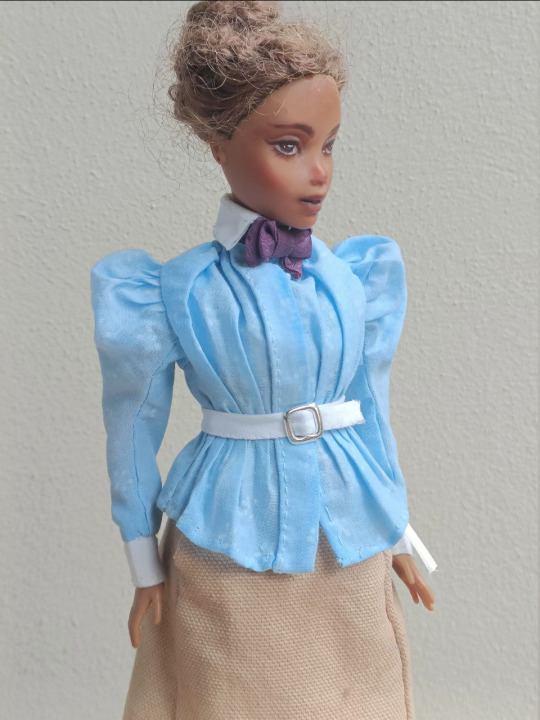
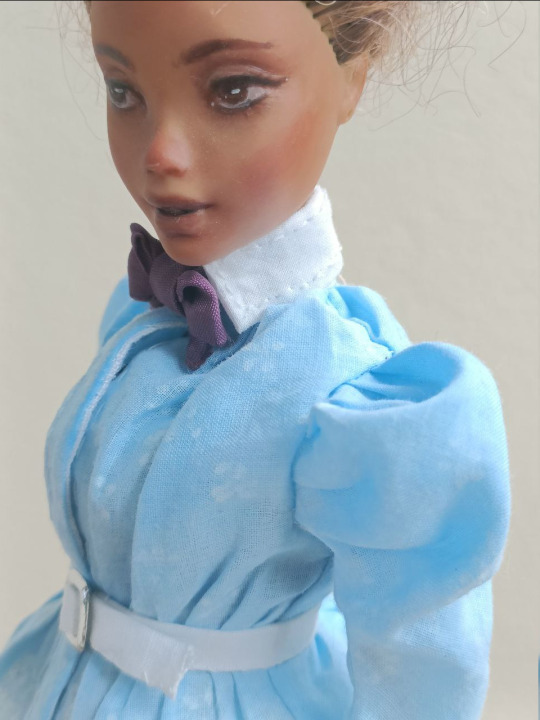
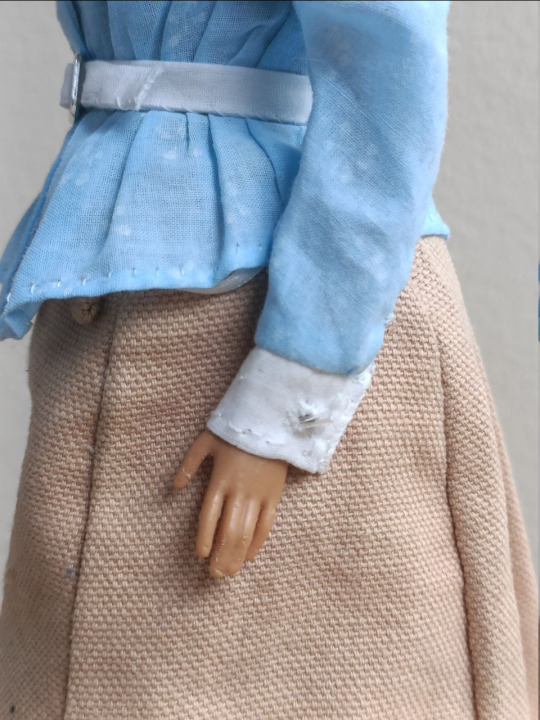
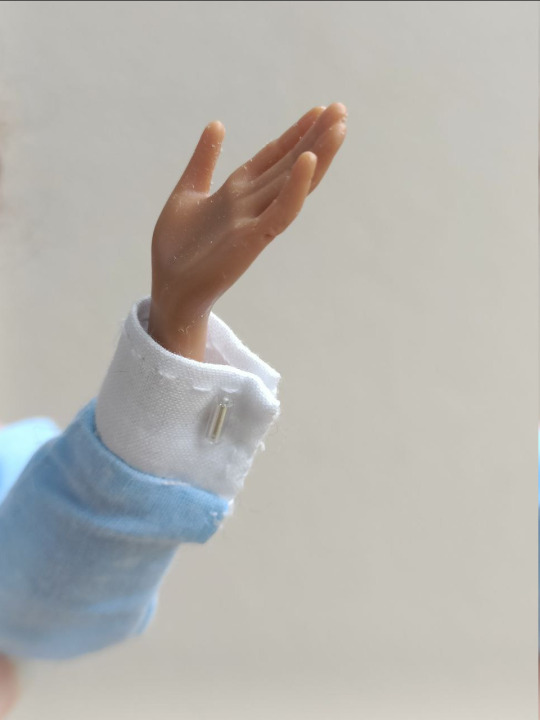
The shirtwaist is from the same cotton as the undergarments. Yes, I dyed it too. I didn't have thin enough cotton in a color that would fit with the skirt and the purple bow, so I dyed it light blue with fabric color. Since I already went the trouble of dyeing I decided I might as well make a small flower print to it since that was popular in the era. I didn't want it to jump out too much but the lighting makes it even less visible. I made it with a white fabric pen. The collar and cuffs are reinforced with linen. I also sewed small stick-like beads to the cuffs on both sides, so one acts as a button (I sewed a buttonhole too) and the other makes it look like they are cufflinks. The bow is from the same fabric as the corset and the belt is sewn from the same cotton as the shirtwaist. The buckle is from a barbie belt.
Waistcoat
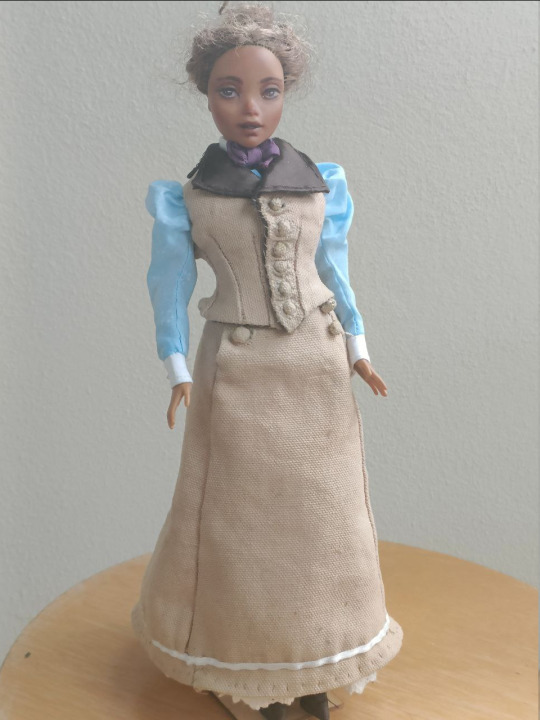
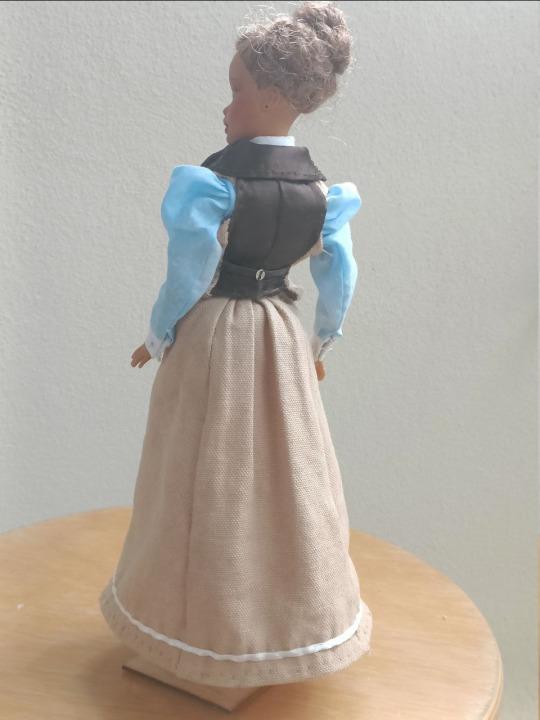
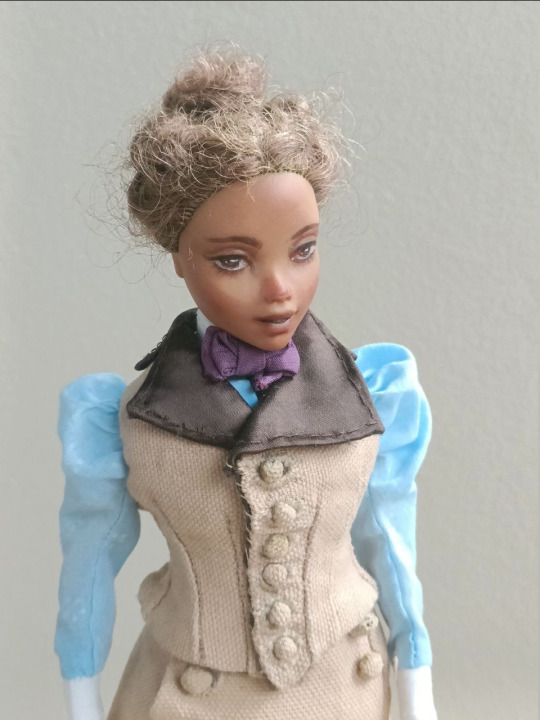
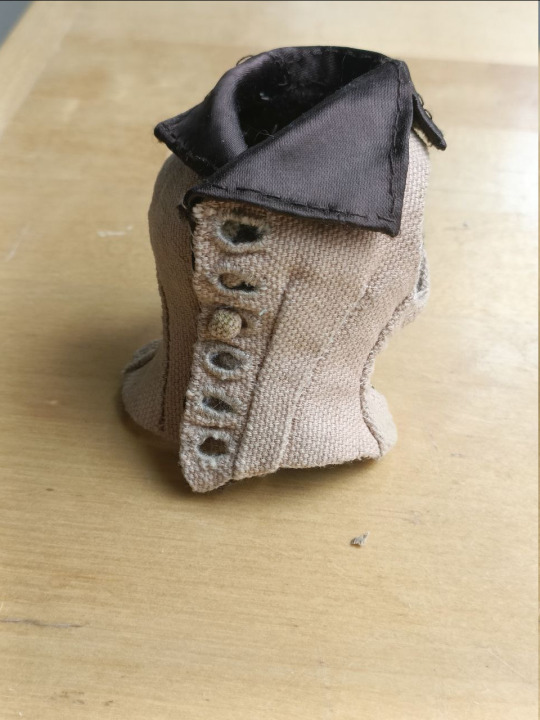
The waistcoat is from the same fabric as the skirt, thought the lapels and the back are from another satin rayon. I tailored the front panels and the lapels by stitching the linen interlining with tailor's stitches (I don't remember if that's the correct word in English) into shape. There is some wonkiness on one side of the hemline for some reason.
Boots
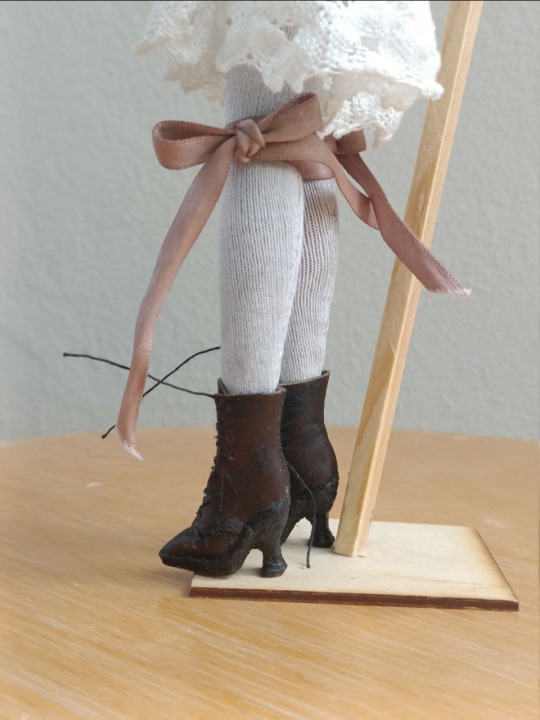

I made the slightly insane decision to make the shoes fully from leather, like they would have been in the period. I had an old broken leather wallet I had saved in case I needed some leather scarps. It has fairly thin leather, so it was workable here. It's light brown though, so I used black shoe polish to darken it. I wanted black or very dark brown shoes. I stacked the heels from glue and leather pieces and carved them into the right shape and sewed the shoe itself to leather shaped as the sole and glued it to the heeled and shaped sole. After I had shaped the shoes and the heels as much as I could I painted the heels black.
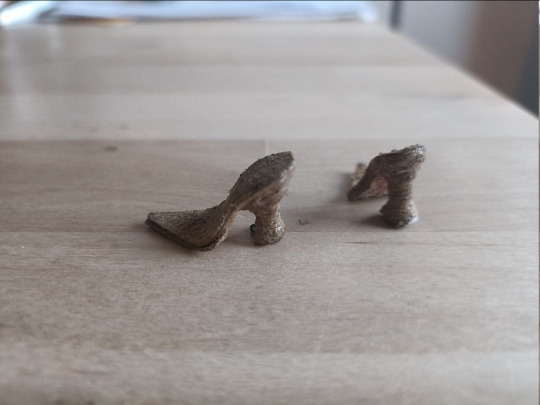
#historical fashion#fashion history#sewing#custom doll#ooak doll#victorian fashion#dress history#costuming#historical costuming#doll clothes#doll customization#historical sewing#my scene#my art#dolls
649 notes
·
View notes
Text
! crossposting from my twitter !
bucktommy costume analysis 👔
hi ! i'm a fashion student and am really interested in costume design so i wanted to do a (long) post on tommy's style and how i think buck might be influenced by it in s8 as seen in "buck's britches." :))
[about tommy]
tommy's wardrobe is entirely functional and indicative of his dedication to his work. it's practical, useful, and speaks of his can-do attitude.
all his signature clothes (henleys, shackets, canvas jackets) have historical traces to being used as workwear.
(1) henleys - this one, ironically in the philippines it has its own term in our local language. it's called a camisa de chino and is used by laborers. although i live in a different country, i'm sure its use case is still the same for other countries as it's historically deemed the workman's undergarment.
also: yes. tommy is technically right. there were henleys in the 80s. even in the 1880s. so what we're learning here now folks, is that he's a smartass little shit.
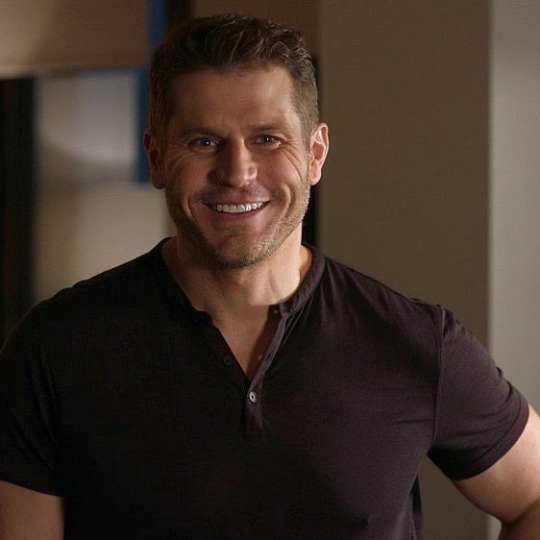


(2) shackets - historically, also an item used by the working class. they were mostly worn to prevent any possible stains on inner clothes from their work (i.e. dirt, grease, grime, etc.)
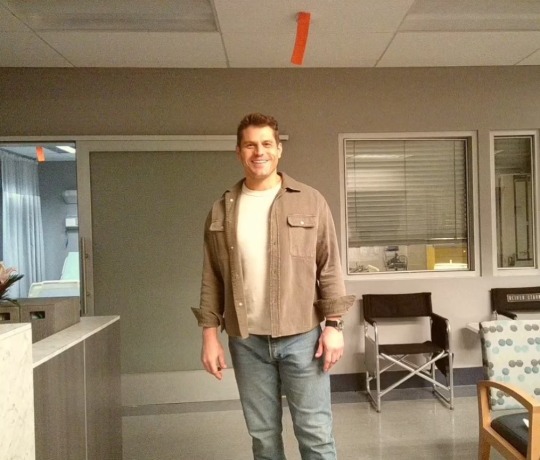

(3) canvas jacket - although this was only seen in 7x04, it's more likely that he still owns a lot more. (waxed) canvas jackets are traditional workwear often used as weatherproof outerwear or heavy duty rainwear.
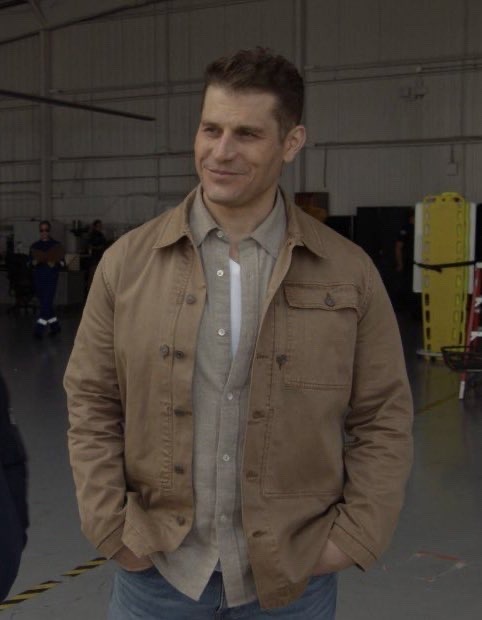
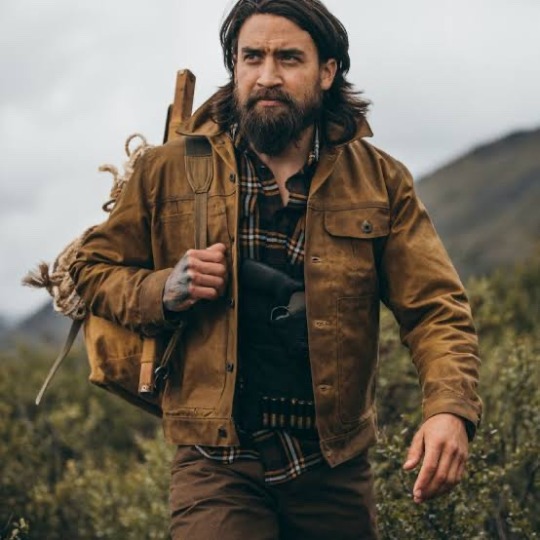
as a form of fun speculation, i'd like to think some of these items are also in his closet:
contrast collar canvas jacket
an authentic flight jacket
overalls, but only for when he fixes up the car
denim trucker jacket
if anything, who better to listen to when talking about tommy's clothes than tommy himself !
here's lou's cameo for me describing tommy's closet as rugged, practical and useful :))
[about "buck's britches"]
now to the "buck's britches" post. two notable items of clothing:
the famous flight jacket
baker pants.

now here's the thing about buck:
buck doesn't wear utilitarian clothing. in fact, he doesn't wear woven clothing all that much. he wears knit. knit polos. sweaters. hoodies. he is not a workwear person. in fact: he's a comfort person.
that's his primary reason for style that's a testament to his own character. buck is widely recognized as the more radiant and funny character. he has charisma and is very inviting, which is accompanied by his choice in clothing.
soft, warm, comfortable.

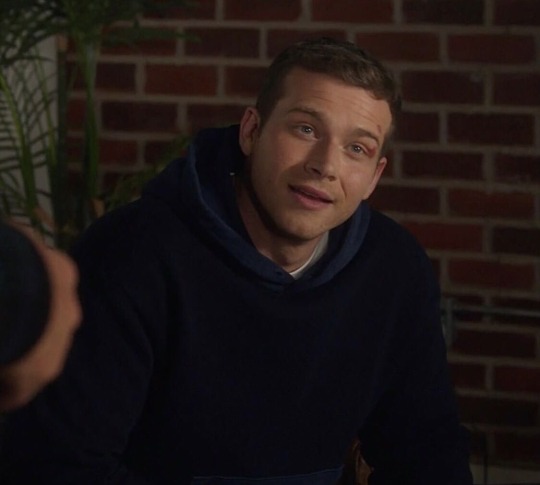
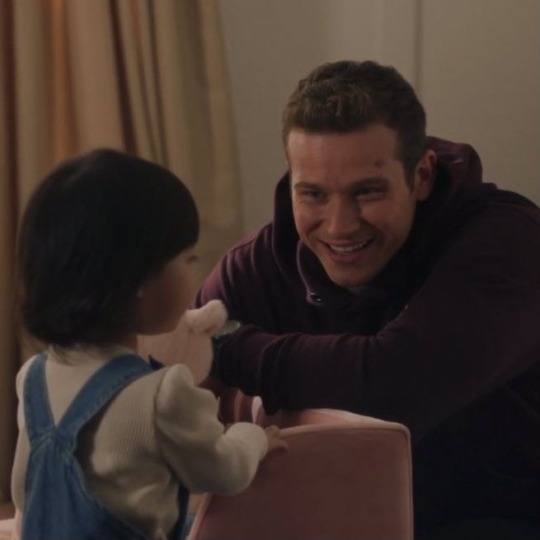
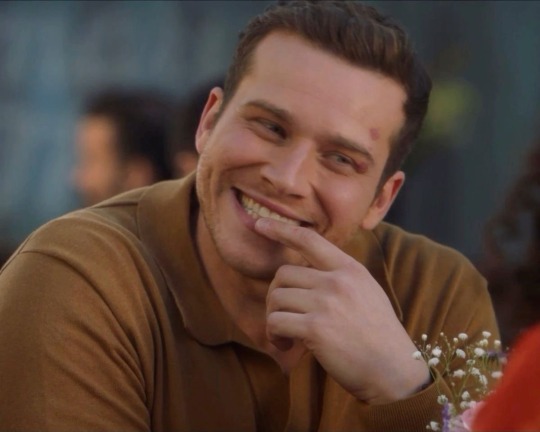
which goes back to the photo ostark posted on his instagram story.
(1) flight jacket - here's where i have to go and burst everyone's bubble for a bit. this is only a flight jacket because it's labelled as such. but categorically, it isn't. flight jackets are the classic term for bomber jackets.
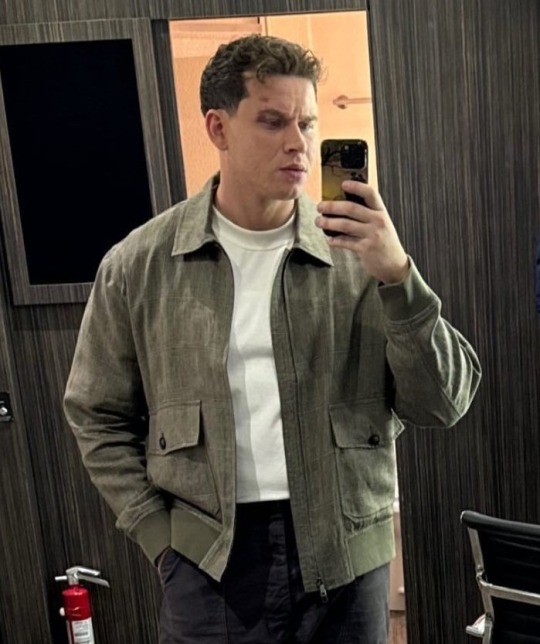
bomber jackets (and flight jackets) were workwear used by the military, characterized by garterized cuffs and hems and short bodices. for pilots, they were interchangeable. but modernly, they have some more definable features.
characteristically, flight (or aviator) jackets are leather with shearling or sherpa collars. bomber jackets are the modernized version taking the silhouette and cuff designs and making them more accessible through material choice (linen—like buck—nylon, silk)


(2) baker pants - as the name suggests, it's a piece of kitchen workwear often in twill (which i'd assume is what oliver is wearing), denim, cotton or linen. it's characterized by the topstitching to outline the pockets and diagonal pocket openings (vs. the usual curve).
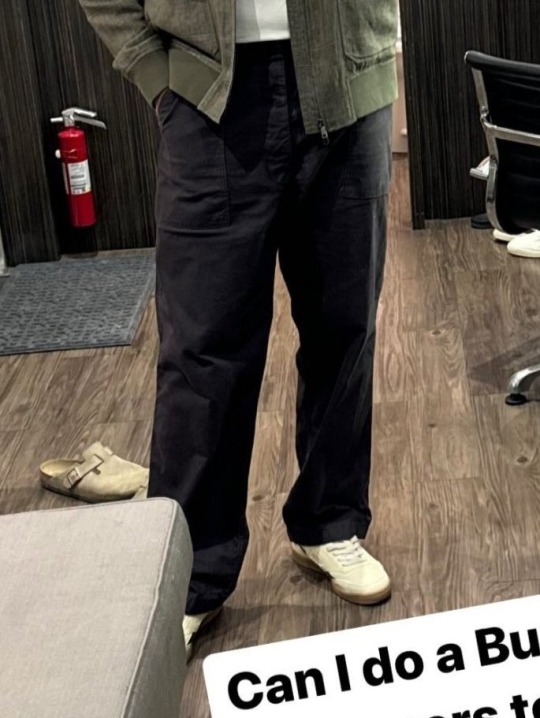
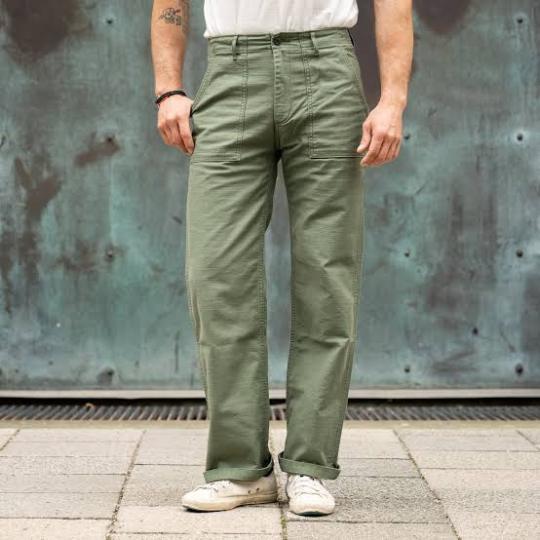
so very evidently: buck has been influenced by tommy's style. he's wearing woven material versus knit for one. if i were hopeful, i'd say they're exploring one another's style because they're sharing a closet.
[character analysis]
woven fabric as a material is sturdy. it's more structured and does not stretch. think: cotton, linen, rayon, wool, denim. what this means for buck is that, by virtue of being tommy's boyfriend he is introduced to structure, groundedness and maturity.
tommy's closet is filled with utilitarian clothing and workwear. he, as a character, is known to be emotionally grounded and mature and it translates to his clothing.
buck adapting the defining features of his wardrobe shows how much tommy has helped him get off his hamster wheel.
in fact, even the inverse can be noted. when buck asks for a second chance and practices communication towards tommy. he's wearing a woven buttondown. and in emphasizing tommy's desire to make buck comfortable, he's in a hoodie. neither of which are common for one another.


buck and tommy, even through subtle clothing choices are becoming part of one another's world and that makes me so soft as someone whose love language is fashion.


[wishful thinking]
perhaps maybe we could see tommy in a fully casual sweat set? i know that they might be protecting lfjr but man. if i see a hoodie on him. (nqueso, if you can sneak me a photo of him in knitwear ill love you forever i just want to prove my theory right i wont even post it)
if they are putting buck in this sort of attire, my guess (or hope) is that they have tommy ease up too.
it would be nice to show buck's effect on tommy as much as tommy's effect on buck because tommy's an established character and has a backstory that the writers could explore.
so if the 9-1-1 costume designers ever see this:
please put tommy in a sweat set. or a hoodie. (not a zip-up one, im talking real hoodie). i'm willing to compromise with overalls. i see what you're doing with buck's wardrobe, and love it. maybe tommy's could soften up too :))
thanks for reading ! 🫶

#911 on abc#tommy kinard#bucktommy#evan buckley#tevan#911 abc#lou ferrigno jr#bi buck#911#costume#costume design#analysis#sorry its a long post im just sort of obsessed with the idea of them sharing closets#my beloved#i love fashion#costume design analysis#contemporary costuming
350 notes
·
View notes
Note
Friend Marzi, why do we have an inclination to believe that all historical clothing was very heavy? Fabrics varied in lightness and for the very heat of summer for example an all-silk or all-muslin ensemble could be made very light and breathable if necessary, even foregoing implements like boning, etc. Like, there are ways to not be dragging your skirts around.
Working people and people with active hobbies were already wearing fewer layers anyway, so we shouldn't expect them to be encumbered. Why do we anyway?
Friend Tumblr User Chasingtheskyline! Hello!
(This answer will focus primarily on conventionally feminine clothing, since that's my area of expertise. Just to disclaim.)
I think it's because of the layering, really. And the idea that, as you touched on, Only Rich People Wore All That (not so much- the basic makeup of chemise/combinations, maybe drawers post-1820s, corset/stays, at least one petticoat, skirt, bodice for women was pretty consistent across most of the social ladder during the 18th and 19th centuries at least) so of COURSE it's heavy and impractical. And as we all know, rich people didn't have lives or do things! They just lounged around being rich and not moving! </s>
We're used to one layer of our mostly-polyester clothing being extremely warming in summer because. It's polyester. Breathability is not something people think about much nowadays, since we're so used to just exposing as much skin as possible to cool down. Ergo, the idea that it's layers of lightweight fabric doesn't really occur to people, I think.
Another element, I think, may be that some of these people have carried reproduction historical garments but never worn them. Or weighed them in a heap on a scale- yes, really -and never taken into account the weight distribution when they're on a body. I've owned garments that were a bear to carry, but perfectly comfortable to wear.
Also, you know. We've long had a vested interest in making our own garments seem like The Best Most Advanced Garments. You can find articles from as early as the 1920s decrying Victorian "trailing skirts and trailing hair" as unhygienic and uncomfortable Never mind that the ADULTS saying this would have known full well that shorter skirts were commonplace for situations where Excessive Dirt would be present and grown women wore their hair up. (Also, you know. Unless you're licking your hem, your skirts cannot get you sick.)
Either you're getting only the experiences of women who hated what they wore before- which would somehow be the same fashion writers who once declared that the gowns of 1915 were the best, or 1910, or 1905 -or they had a vested interest in selling something to the public: in this case, the hottest, newest clothes (and hairstyles that required more regular trips to the hairdresser than long hair pinned up). Of course you get those writers calling earlier clothing heavy- they're trying to get people to buy rayon flapper dresses!
Now, does that mean that nobody in history found their clothing heavy? Of course not. One of Amelia Bloomer's key complaints about the fashions of the 1840s and early 50s was the many layers of petticoats women often wore to create the fashionable skirt shape- and while I'm often loath to take dress reformers as sole arbiters of women's opinion, the invention of the cage crinoline/hoop skirt was widely hailed as a marvel for enabling big skirts with much less weight.
But you're so right that this perception is extremely exaggerated nowadays. I do my best to fight it- had this conversation with a colleague today, as I was wearing a long-sleeved blouse of cotton voile and a long cotton skirt to work in 80-degree (F) weather -but. Well. It DOES get frustrating at times.
126 notes
·
View notes